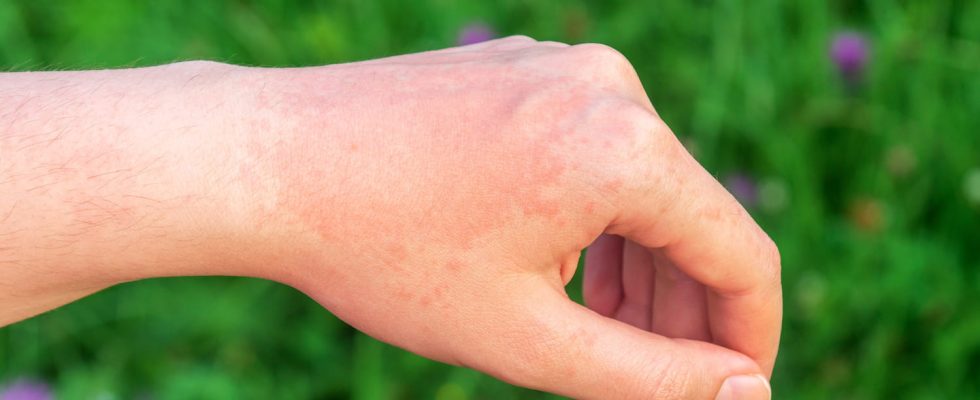Lucite is a common sun allergy, especially among women. It is manifested by an eruption of the skin (face, hands, eyes, etc.) triggered by the rays of the sun. Symptoms, causes, drugs… We take stock.
Lucite is an allergy to the sun. The most common is summer lucite which is benign. There is also polymorphic lucite. Lucite would touch approximately 10% of adults, usually women and between 15 and 20 years old. How to recognize it? Treat her? What cream?
Definition: what is lucite?
There lucite is an allergy to the sun (sun allergy). It manifests itself whenSun exposure and concerns 10% of the population, mainly female. There are generally 2 forms of Lucite:
- There benign summer lucitethe most frequent,
- There polymorphic lucite.
Benign summer lucite
“Benign summer lucite (LEB) is characterized by an eruption on areas not accustomed to the sun such as the arms, the décolleté, during the first exposure to the sun. It passes in a week, sometimes less, sometimes more“, informs Dr. Jean-Marc Chavigny, dermatologist and allergist. Benign summer lucite particularly affects women aged 15 to 35. It can reappear quickly after further exposure.
Polymorph Lucite
“Polymorphic Lucite is much more prominent and affects the face. She doesn’t pass with the summer“, informs the dermatologist and allergist. This form of lucite occurs in the conditions of sun exposure of everyday life from spring to autumn. It is therefore much more disabling. “It requires medical treatment“, informs this doctor.
Solar urticaria
There is another form of sun allergy:solar urticaria. It is characterized by rashes that occur very quickly after exposure to the sun, then disappear once in the shade.
What are the symptoms of lucite?
Of the small red pimples or blistersaccompanied by itching, appear a few hours after exposure to the sun. These rashes are localized on the exposed areas of the body in case of summer lucite:
- at shoulder level,
- arms,
- legs,
- of the neckline.
Polymorphic lucite affects the neckline and arms, but also the face, the back of the hands and behind the ears. Symptoms last about a week for benign summer lucitis and persist for more than 10 days in polymorphic lucitis.
When and who to consult?
“If after 10 days a lucite does not pass and if it touches the face, it is necessary to consult a dermatologist“, warns the dermatologist and allergist. “It is also necessary to consult when the symptoms of lucite are associated with other symptoms, such as joint pain. This lucite associated with other symptoms can be a sign of lupus for example“
The treatment for benign summer glaucitis consists of the application of corticosteroid creams to the affected areas. Sprays of soothing and anti-inflammatory thermal water several times a day reduce burning sensations. Progressive exposure to the sun is essential to avoid recurrences of sun allergy. Exposing yourself little at the beginning of the exposure allows desensitization.
What drugs to treat lucite?
“It is better to use special LEB creams which let some of the UV rays through so that the skin gets used to the sun. If we protect ourselves completely we have again a lucite“, advises Dr. Jean-Marc Chavigny.”It is also possible to take Beta-carotene 15 days before exposure to the sun and during the first week to reinforce the protection of the skin.“, he explains. As a precaution, taking beta-carotene is not recommended for smokers. Sun creams containing vitamin E or Aloe vera could be more effective but this is not scientifically proven. .
Which essential oils to treat lucite?
Distrust, on the other hand, with essential oils to treat or prevent lucite. “Essential oils are photosensitizing and there is a risk of significant pigmentation. There is also a risk of allergy“, warns Dr. Jean-Marc Chavigny.
The treatment of polymorphic lucite is based on strong sun protection and taking an anti-malarial drug, which is a photoprotector (Plaquenil®, Nivaquine®)
Thanks to Dr. Jean-Marc Chavigny, dermatologist and allergist.
